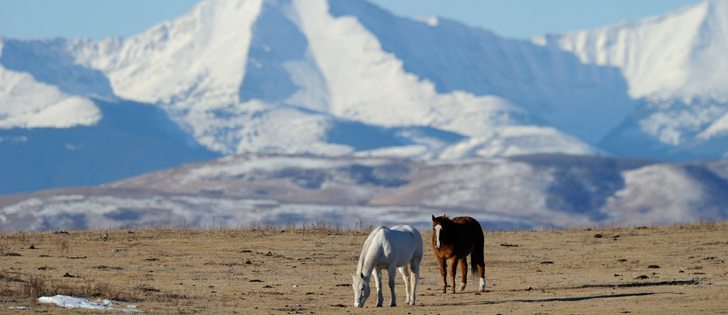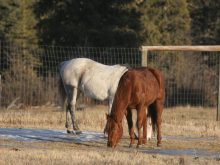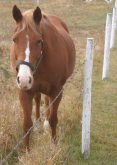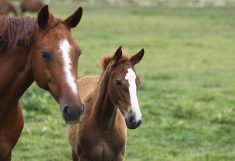Many owners consider horses to be pets | Old horses can have sway backs, grey hair, poor teeth and hoof wear
It used to be that old horses were called, well, old horses. Now the term geriatric is used to describe a horse getting up there in years.
As humans live longer, it would seem the horse population is doing the same. Some of the terminology invented for humans, such as geriatrics, is the same for horses.
Rightly so, says Dr. Katharina Lohmann of the University of Saskatchewan’s Western College of Veterinarian Medicine, who specializes in large animal internal medicine.
“The knowledge is increasing,” she told the Equine Expo in Saskatoon Feb. 18.
Read Also

Growth plates are instrumental in shaping a horse’s life
Young horse training plans and workloads must match their skeletal development. Failing to plan around growth plates can create lifelong physical problems.
“I always find it interesting how all the research that gets done in animals for the purpose of helping humans ultimately comes back to the animals. Now we’re starting to talk about geriatric diseases in animals and a lot of that is actually based on what we know about humans, which I’m sure at some point has come from animal research. To me it sometimes feels like this cycle is closing.”
Lohmann said there have been no official Canadian studies, but the perception is that horses are living longer because they’re healthier.
As well, owners may be more willing to keep older horses around as pets.
“Maybe we’re going towards a population of horses where the emotional attachment is higher than it used to be if one looked back 50 or 100 years,” she said.
Responsible horse ownership was at the heart of Lohmann’s one hour seminar.
“Young horses get older. What are you going to do when that horse gets older, what can you expect and what are your options?” she said.
Horses older than 15 are considered geriatric. Common physical characteristics of old age in horses include swayback, drooping lips, grooves above the eyes, graying hair and tooth and hoof wear.
Problems can include weight, athletic purpose, rider safety, reproductive capacity and quality of life.
Obesity can be an issue, but weight loss is the bigger problem.
“In the fall and towards the winter, we’re presented with horses that are thin, where owners are concerned about getting them through the winter,” she said.
Causes of weight loss include inability to eat (dental disease, competition), increased nutrient requirements (demand versus supply), loss of appetite and nutrient loss through diseases.
Lohmann said a recent survey found that horse owners often underestimate the severity of their animals’ health problems.
For example, 24 percent of the owners suspected dental abnormalities but examination showed 95 percent of old horses had teeth problems.
“The take home message is that with an older horse, it may be worthwhile doing regular veterinary examinations to pick up problems that maybe go unnoticed, even to a very observant owner,” she said.
Lohmann said horse owners also need to think about end of life decisions before they happen.
“Whether you like it or not, as a responsible horse owner, I think you’ve got to think about what are you going to do with that horse if it’s ill, or if it’s old or it has outlived its purpose.”
Lohmann said a recent British survey of 200 horse owners found that 94 percent of deaths in old horses were the result of euthanasia. Of those, 24 percent were euthanized because of lameness and 20 percent because of colic problems.
She said the decision to euthanize was often based on the owner’s perception of the horse’s poor quality of life.
“Quality of life in horses is something that we haven’t really investigated very much,” she said.
A quality of life assessment would include looking at the horse’s mobility, eating ability and appetite, pain and discomfort, mental capacity, “happiness” and response to treatment.
Marion Bear of Muskoday, Sask., who attended the seminar, said she has raised horses for about 40 years and has had to euthanize older horses. She was also concerned about the welfare of a horse with a previous injury.
“I wanted to evaluate what our handling of the previous situations has been to see if we actually were doing what was in the best services of the animals,” she said.
Lohmann credits the American Association of Equine Practitioners for bringing the issue of euthanasia into the open, promoting dialogue about the unwanted horse issue and educating owners on the options.
“If the first time you think about it is in a very stressful, pressure environment, it just augments it so much,” she said.
“I would really encourage people to make that part of their ownership program.”
Bear agreed: “You have to be watching your animals and be quite aware of how they are doing, what the changes are and whether there is, from our perceptions, sufficient pain (to justify euthanasia),” she said.









![Conservative agriculture critic and Alberta Foothills MP John Barlow said some [people who raise horses for the overseas meat market] were harassed and bullied and wanted no part of the study, even though they could lose their livelihood if the bill is passed. | File photo](https://static.producer.com/wp-content/uploads/2024/04/30150023/03-BJM121610horse-feedlot-235x165.jpg)






